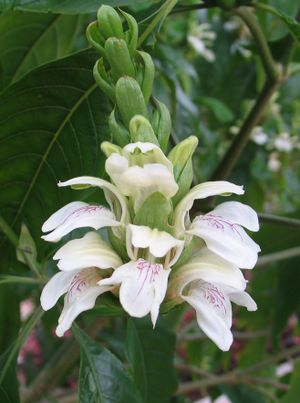Note: This is a project under development. The articles on this wiki are just being initiated and broadly incomplete. You can Help creating new pages.
Justicia adhatoda - Simhaparni
Simhaparni is sanskrit name of Adhatoda Zeylanica Medikus (Botanical Name). Simhaparni commonly known in English as Malabar Nut is a medicinal plant native to Asia, widely used in Siddha Medicine, Ayurvedic, homeopathy and Unani systems of medicine.
The plant's range includes Sri Lanka, Nepal, India, Pakistan, Indonesia, Malaysia, and China, as well as Panama where it is thought to have been introduced.
In an ancient period, Ayurvedic Scholars had involved yoga and kundalini in their medicinal practises. They have strongly believeed that, Human respiratory and nerves system have the closest relationship. Therefore they have thought that pranayama makes human nerves system, memory power and intelligence more effective. For this purpose, Lungs should be healthy. Therefore, they have started thinking about Simhaparni's uses and how to use it.
Contents
Plant description
Simhaparni is a shrub with the height of 5 to 6 feet. They are oppositely arranged, smooth-edged, and borne on short petioles. Leaves are lance in shape and flowers are white in colour.
Useful parts of the plant
- Root, Leaf. Flower, Stem
Traditional Medicine
- This shrub has a number of traditional medicinal uses in Siddha Medicine, Ayurvedic and Unani systems of medicine.
Medicinal Uses
- Joint Pain - Applying the paste of the Simhaparni leaf to the joint, would give the relaxation.
Simhaparni is also helpful for other diseases like :-
- Cough, skin itchiness, Animia, piles, ...etc
common name
- English - Malabar Nut
- Kannada - ಆಡುಸೋಗೆ
- Hindi - वासा
